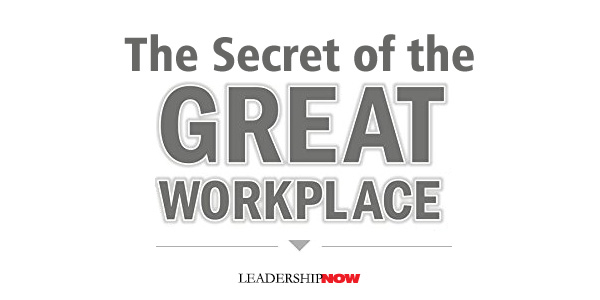 |
 |
01.19.11

The Secret of the Great Workplace
WHAT LEADER wouldn’t want to lead a “great workplace?” I’ve never run across anyone that wouldn’t. So why aren’t we able to point to more of them? I suspect that, in the main, it’s because many of those leaders that don’t lead great workplaces, don’t know they aren’t. They have never taken the time to ask. From their point of view it’s hard to imagine what they could be doing differently. But, it is those you lead that determine whether or not working with you constitutes a great workplace. Even if you are not the CEO, you can create a great workplace around you. To begin, you need to ask, “What is it like being lead by me?” You make the difference. In The Great Workplace, authors Michael Burchell and Jennifer Robin write, “you need to do your job realizing that how you do what you do makes a world of difference to employees.” The secret of great workplaces is relationships. Relationships between employees and their leaders, between employees and their jobs, and between employees and each other are the three indicators of a great place to work. “If leaders implemented practices and created programs and policies that contributed to these three relationships, employees had a great workplace experience.” The important part is that whatever they did, it had to be done in a way that strengthened relationships.When the authors asked, “Why is your organization a great place to work?” a consistent model emerged. (See below.) The employees said “they believe their leaders to be credible, respectful, and fair—they trust them. They also take pride in what they do, and they share a sense of camaraderie with their coworkers.” Because the relationships you create matter, you're the critical difference between a very good company and a very great company. In the best companies, leaders at all levels have a strong commitment to creating strong ties between the employee and the organization. Indeed, enhancing trust, pride, and camaraderie in the workplace is the central task of effective leadership in today’s organizations. They suggest that what holds leaders back from doing something about this is not having the faith that there are bottom-line results from doing the right thing. Another excuse is no time. Lack of situational awareness and the belief that they should just be focusing on the business also keep leaders from focusing on the relationships that really underlie everything they do.
After building a rational business case for the need to create great workplaces, the authors get into detailing each aspect of the model. It is thorough enough to give you a clear way forward in creating a great workplace in your own situation. With anecdotes, best practices, and quotes from employees working at the best workplaces in the U.S., they give the great workplace a tangible shape. At Analytical Graphics, the president compiles a weekly log of individual, team, and organizational accomplishments he hears about, witnesses, or comes across during the week, and he shares those every Friday at the weekly company lunch (yes, all 275+ employees come together for lunch and a short meeting). Whether it is an item he pulled from the local newspaper about an employee’s efforts in the community, or a milestone that a team passed in developing a product, or how teammates pulled together to help one another out on a particular issue, he makes this a consistent practice. And employees feed off this energy. “Friday afternoon,” one employee commented to us, “is always a high. What a great way to start the weekend, and make me excited to come back on Monday morning.” Does your feedback make your people want to come back and do it again? Do you even give timely feedback? >They encourage leaders not to create something completely new and different, but instead to improve upon what you are already doing. Best practices referred to in the book serve to illustrate ways trust, pride and camaraderie might be built in your own situation, but they are culture-specific. Things get in the way of letting people be human. Particularly quarterly reports and business schools. I think what we try to do is make it very clear that what’s important is doing the right thing. And if we do the right thing, all the other things take care of themselves.” The Great Place to Work Institute has found that great workplaces exist regardless of size, industry, or location because the Model is based on universal “needs and values—trust of the people you work for, pride in what you do, and enjoyment of the people you work with.” The Great Workplace Institute is worth a visit for additional resources and information. 
Posted by Michael McKinney at 08:27 AM
|
BUILD YOUR KNOWLEDGE
 

How to Do Your Start-Up Right STRAIGHT TALK FOR START-UPS 
Grow Your Leadership Skills NEW AND UPCOMING LEADERSHIP BOOKS 
Leadership Minute BITE-SIZE CONCEPTS YOU CAN CHEW ON 
Classic Leadership Books BOOKS TO READ BEFORE YOU LEAD |